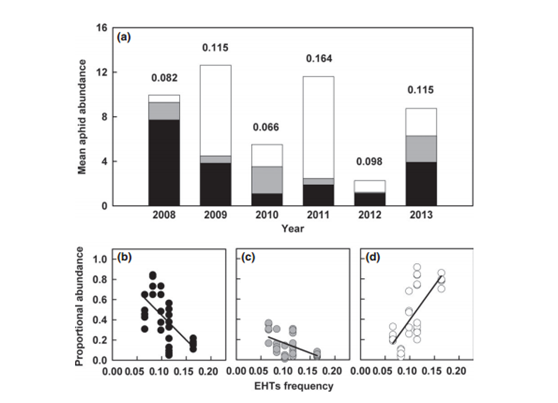农科院植保所马春森研究团队发现气候变化正在改变麦蚜的优势
近日,从中国农业科学院植物保护研究所获悉,该所马春森研究团队通过6年的潜心研究发现,全球气候变化打破了农业害虫群落原有的平衡,改变了害虫群落物种间的相对优势度,使优势种(群落中具有最大密度、盖度和生物量,对生境影响最大的物种)发生了演替,气候变化正在改变农业害虫群落的优势种。相关研究成果发表在最新一期国际知名期刊《全球变化生物学(Global Change biology)》上。

全球气候变化给生物带来了新的选择压力,然而物种间对这种选择压力的响应可能不同,进而造成物种间相对优势度和群落结构的改变。为阐明全球气候变化导致的极端高温事件幅度和频率增加与农业害虫群落物种间相对优势度和群落结构之间的关系,马春森研究团队以共同发生的三种麦蚜(麦长管蚜、禾谷缢管蚜、麦二叉蚜)为模式系统,首先采用实验室模拟的方法证实了极端高温事件幅度和频率增加对三种麦蚜发育、存活、繁殖及种群适合度的影响有显著差异,即极端高温幅度和频率增加,禾谷缢管蚜的相对适合度由低变高,而麦长管蚜和麦二叉蚜则由高变低。田间模拟增温试验同样表明,极端高温事件幅度和频率增加改变了三种麦蚜的群落结构,禾谷缢管蚜的相对优势度显著增加,另外两种麦蚜则明显降低。
为期6年的田间种群数据调查发现,极端高温事件改变了三种麦蚜在时间上的相对优势度和群落结构,即极端高温事件频发的年份,禾谷缢管蚜的相对优势度较高;而极端高温事件发生较少的年份,麦长管蚜和麦二叉蚜的相对优势度较高。此外,全球不同地区的数据分析发现,极端高温事件还改变了这三种蚜虫在大尺度空间上的相对优势度和群落结构,极端高温事件发生概率较小的高纬度地区,麦长管蚜和麦二叉蚜为群落的优势种;而极端高温事件发生概率较大的低纬度地区,禾谷缢管蚜则在群落中占据非常明显的优势。
由于三种麦蚜的为害部位及其造成的经济损失明显不同,相对优势度的改变将显著影响麦蚜防治经济阈值的制定。此外,这三种麦蚜在传播麦类作物病毒病的种类和传毒效率上有显著差异,因此其群落结构和相对优势度的改变能显著影响麦类作物的病毒感染率及病害的发生流行,进而影响病害发生预测和防控策略的制定。麦蚜处于麦田生态系统中间营养级,其群落结构的改变,还将对“作物-麦蚜-天敌”系统造成影响。该研究采用的室内及田间的模拟方法,以及多年田间观测分析和全球数据元分析(meta-analysis)的综合研究方法,在个体和群落的水平上来分析害虫物种间对全球气候变化的响应及其差异,对预测气候变化对害虫及其群落的影响具有重要的应用价值。
原文链接:
Extreme temperature events alter demographic rates, relative fitness, and community structure
原文摘要:
The frequency and magnitude of extreme events are predicted to increase under future climate change. Despite recent advancements, we still lack a detailed understanding of how changes in the frequency and amplitude of extreme climate events are linked to the temporal and spatial structure of natural communities. To answer this question, we used a combination of laboratory experiments, field experiments, and analysis of multi-year field observations to reveal the effects of extreme high temperature events on the demographic rates and relative dominance of three co-occurrence aphid species which differ in their transmission efficiency of different agricultural pathogens. We then linked the geographical shift in their relative dominance to frequent extreme high temperatures through a meta-analysis. We found that both frequency and amplitude of extreme high temperatures altered demographic rates of species. However, these effects were species-specific. Increasing the frequency and amplitude of extreme temperature events altered which species had the highest fitness. Importantly, this change in relative fitness of species was consistent with significant changes in the relative dominance of species in natural communities in a 1 year long field heating experiment and 6 year long field survey of natural populations. Finally, at a global spatial scale, we found the same relationship between relative abundance of species and frequency of extreme temperatures. Together, our results indicate that changes in frequency and amplitude of extreme high temperatures can alter the temporal and spatial structure of natural communities, and that these changes are driven by asymmetric effects of high temperatures on the demographic rates and fitness of species. They also highlight the importance of understanding how extreme events affect the life-history of species for predicting the impacts of climate change at the individual and community level, and emphasize the importance of using a broad range of approaches when studying climate change.
DOI: 10.1111/gcb.12654
作者:生物帮

